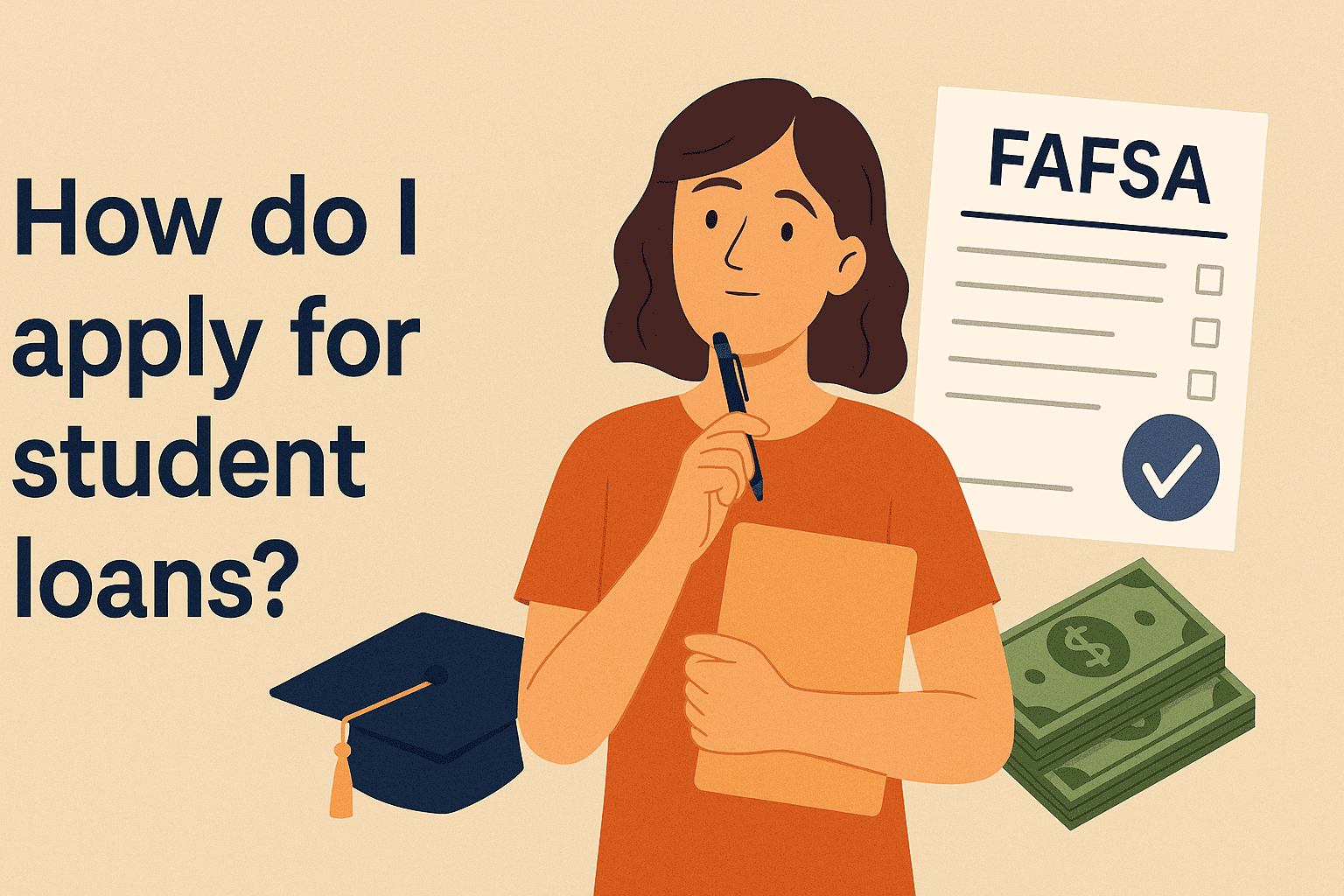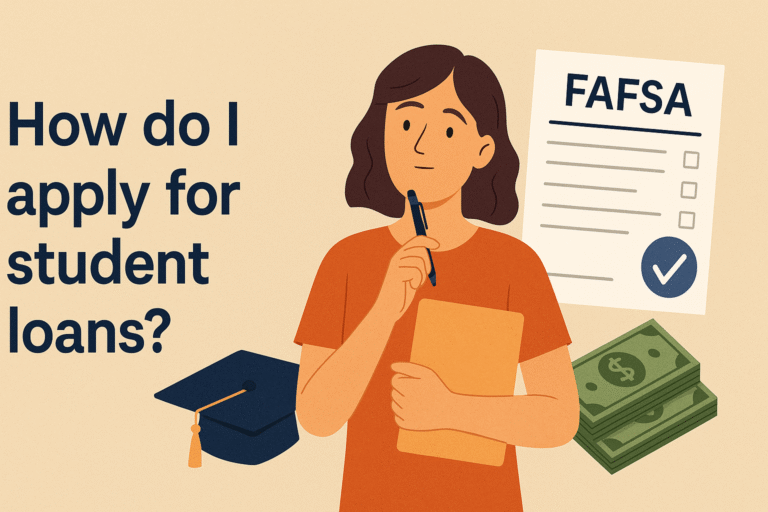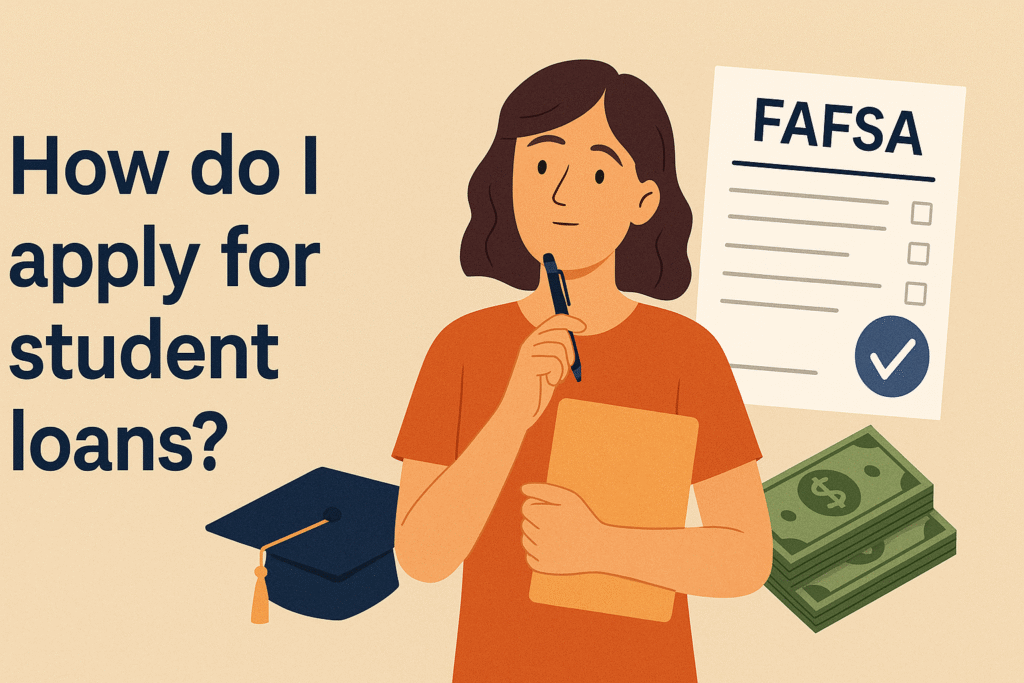Figuring out how to pay for college can feel overwhelming, but understanding how to apply for student loans makes the process easier and far less stressful. Whether you’re exploring federal aid programs, private loan options, or ways to start your financial journey with small investments, knowing the right steps upfront will save you time and money.
Before diving in, it’s smart to look at your overall financial picture. For instance, thinking about long-term investing strategies like index funds or even learning how beginners can start investing with just $100 can help you balance borrowing with building a future safety net. At the same time, economic factors like global inflation’s impact on personal savings or rising costs in other sectors, such as whether higher auto tariffs will push car prices out of reach, show why making informed choices about student loans matters more than ever.
This guide walks you through each step of the application process, from preparing documents to comparing lenders. By the end, you’ll have a clear path to securing the funding you need for school and a better understanding of how to avoid turning your education into a costly mistake, much like buying a car at the wrong time.
Understanding Student Loans
Before you apply, it’s crucial to understand what student loans are and how they fit into your financial future. A student loan is borrowed money that helps cover the cost of tuition, books, housing, and other educational expenses. Unlike scholarships or grants, loans must be repaid with interest, which means you’re taking on a long‑term financial commitment.
There are two main categories: federal student loans and private student loans. Federal loans are backed by the government and typically offer lower interest rates, flexible repayment plans, and even options for forgiveness in certain careers. Private loans come from banks or credit unions and can fill funding gaps, but they often carry stricter terms and higher rates.
Understanding these differences isn’t just about comparing numbers. It’s about looking at your overall money strategy. For example, exploring topics like index funds for long‑term investing or learning how beginners can start investing with just $100 can help you see how borrowing for school fits into your bigger financial picture.
It’s also smart to think about how economic shifts affect borrowing and repayment. Issues like global inflation’s impact on personal savings or major market changes, even things like higher auto tariffs driving car prices up, can influence interest rates, your budget, and how quickly you can repay what you owe.
By grasping the basics now, you’ll make smarter decisions when you apply, borrow only what you need, and avoid turning your degree into a financial burden similar to buying a car at the wrong time.
Step‑by‑Step Application Process
Applying for student loans might feel complicated at first, but breaking it into clear steps makes the process straightforward. Here’s how to move from planning to funding without missing key details.
1. Review your financial needs
Start by calculating how much you need to borrow. Factor in tuition, housing, books, and living expenses. Borrowing wisely now can save you thousands later, just like making smart choices about investments such as index funds for long‑term growth, or even starting to invest with just $100 helps you build a secure future.
2. Complete the FAFSA early
The Free Application for Federal Student Aid (FAFSA) is your gateway to federal student loans, grants, and some scholarships. Submit it as early as possible to maximize your aid options. Missing deadlines could mean relying more on private loans with higher rates.
3. Compare federal and private loan options
Federal loans typically have lower interest and more flexible repayment plans, but they may not cover all costs. If you consider private loans, shop around. Lenders adjust rates based on economic trends, and shifts like global inflation affecting personal savings can impact the terms you get.
4. Gather necessary documents
You’ll need proof of income, identification, and sometimes credit history for private loans. Staying organized helps speed up the process and prevents costly delays.
5. Accept your loan offer carefully
Read every line before signing. Understand the repayment schedule, interest rates, and any fees. Think of it like deciding if buying a car is a financial win or a costly mistake. You don’t want surprises later.
6. Plan for repayment before you borrow
Even before funds are disbursed, map out how you’ll pay them back. Consider how future expenses from rent to rising costs in areas like auto tariffs, pushing car prices out of reach, might affect your budget.
By following these steps carefully, you’ll secure the funding you need while keeping your debt under control and protecting your financial future.
Choosing Between Federal and Private Loans
One of the most important decisions when borrowing for college is whether to rely on federal student loans, private loans, or a mix of both. Understanding the trade‑offs can save you money and stress for years after graduation.
Federal student loans are backed by the government and usually come with lower interest rates, fixed terms, and borrower protections like income‑driven repayment or loan forgiveness for certain careers. They don’t require a strong credit history, making them the best starting point for most students.
Private student loans, offered by banks and credit unions, can help fill gaps when federal aid isn’t enough. But they often come with variable rates, stricter eligibility requirements, and fewer repayment options. Your credit score or your cosigner’s heavily influences the terms you’ll get.
Before committing, think about how borrowing fits into your overall money strategy. For instance, learning about index funds for long‑term investing or starting with just $100 can give you perspective on balancing debt with future wealth building.
Economic conditions matter too. Rising costs, such as global inflation cutting into personal savings or shifts like auto tariffs pushing car prices higher, can impact interest rates and how quickly you’ll be able to repay.
The smartest move? Exhaust federal options first, then carefully compare private lenders if you still need more funding. This way, you avoid turning your education into a costly mistake like buying a car at the wrong time.
Managing Repayment Options
Graduation might feel like the finish line, but when it comes to student loans, it’s the start of the repayment journey. Managing repayment options wisely can save you thousands of dollars and years of stress.
1. Understand your grace period
Most federal loans offer a six‑month grace period before payments begin. Use this time to organize your finances, build an emergency fund, and even explore ways to grow your money, like starting to invest with just $100 so you’re ready when the first bill arrives.
2. Choose the right repayment plan
Federal loans give you several choices: Standard Repayment, Graduated Repayment, and Income‑Driven plans. Income‑Driven Repayment can cap your monthly payment at a percentage of your income, which helps if you’re just starting in your career.
3. Stay alert to refinancing opportunities
Private loan borrowers may save money by refinancing to a lower rate. But timing matters. Factors like global inflation affecting personal savings or shifts in the economy can change rates quickly.
4. Avoid common repayment traps
Ignoring loan statements or skipping payments can lead to default and damaged credit. It’s similar to buying a car at the wrong time and ending up with payments you can’t manage, like in this look at car costs and tariffs.
5. Build a payoff strategy
Even small extra payments can chip away at your balance and reduce the total interest you’ll pay. Think of it like choosing smart investments such as index funds for long‑term gains: consistent effort now leads to big rewards later.
By staying proactive and informed, you’ll turn repayment from something overwhelming into a clear, manageable financial plan — one that keeps your future secure even when outside costs, like auto tariffs pushing car prices out of reach, continue to rise.
Mistakes to Avoid
When it comes to student loans, avoiding the wrong moves is just as important as following the right steps. Many borrowers unknowingly make choices that cost them thousands or add years to their repayment timeline. Here are the biggest pitfalls to watch for.
1. Borrowing more than you need
It’s tempting to accept every dollar offered, but overborrowing leads to unnecessary debt. Treat student loans like any other major purchase. You wouldn’t overspend on a car without thinking about the payments, just like in this breakdown of car costs and tariffs.
2. Ignoring interest rates
Many students focus only on the loan amount and overlook how much interest will add over time. Understanding rates is as important as knowing how index funds can drive long‑term growth. The earlier you pay attention, the better your financial outcome.
3. Skipping the FAFSA
Some students think they won’t qualify for aid and never submit the Free Application for Federal Student Aid. This mistake can lock you out of grants and lower‑rate federal loans, forcing you to rely on private lenders.
4. Missing payments or ignoring statements
Falling behind on payments damages your credit and can lead to default. It’s like letting global inflation chip away at your savings — the problem grows quietly until it’s overwhelming.
5. Failing to plan for repayment
Too many borrowers wait until after graduation to think about how they’ll pay back loans. Planning, even if it means starting small with $100 investments, creates habits that make repayment smoother.
6. Overlooking economic factors
The economy influences loan rates, job markets, and repayment strategies. Shifts like auto tariffs pushing car prices out of reach can squeeze your budget and make repayment harder if you aren’t prepared.
By steering clear of these mistakes, you’ll keep your borrowing under control and protect your financial future long after graduation.
Conclusion
Applying for student loans doesn’t have to feel overwhelming. By understanding your options, following a clear application process, and borrowing only what you need, you set yourself up for financial stability long after graduation.
Federal loans should almost always be your first choice, thanks to their lower rates and flexible repayment plans, but if you need private loans, compare lenders carefully. Thinking ahead the same way you would when learning about index funds for long‑term investing or how global inflation impacts savings helps you make smarter borrowing decisions.
Remember, every dollar you borrow today is one you’ll repay tomorrow. Avoiding common pitfalls, like overborrowing or missing payments, will keep you from turning your education into a costly mistake similar to buying a car at the wrong time.






























